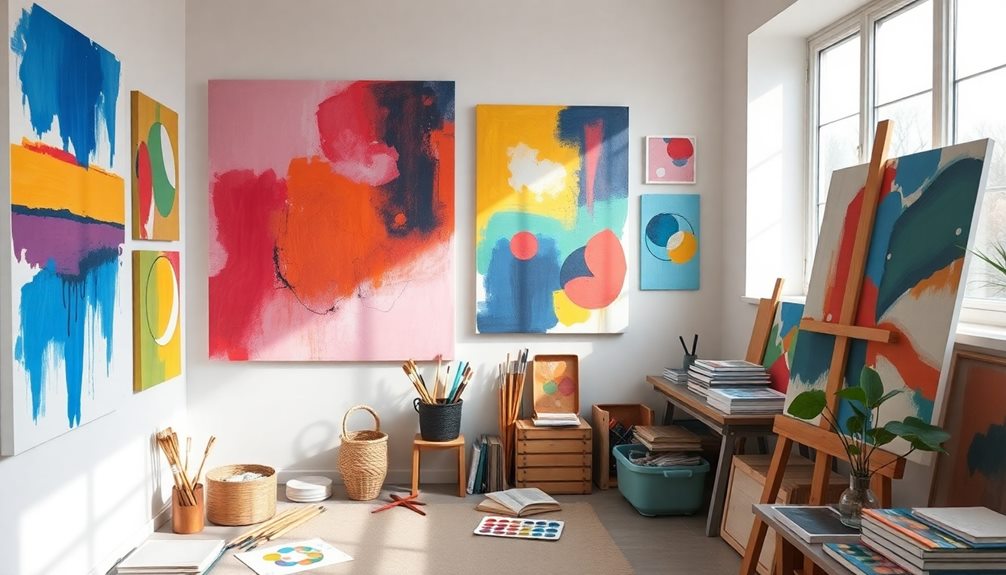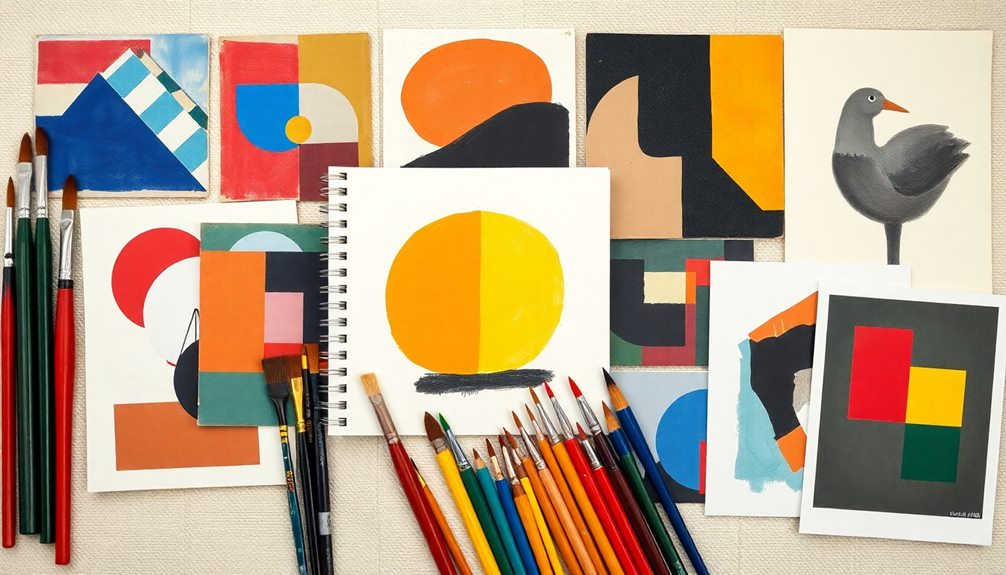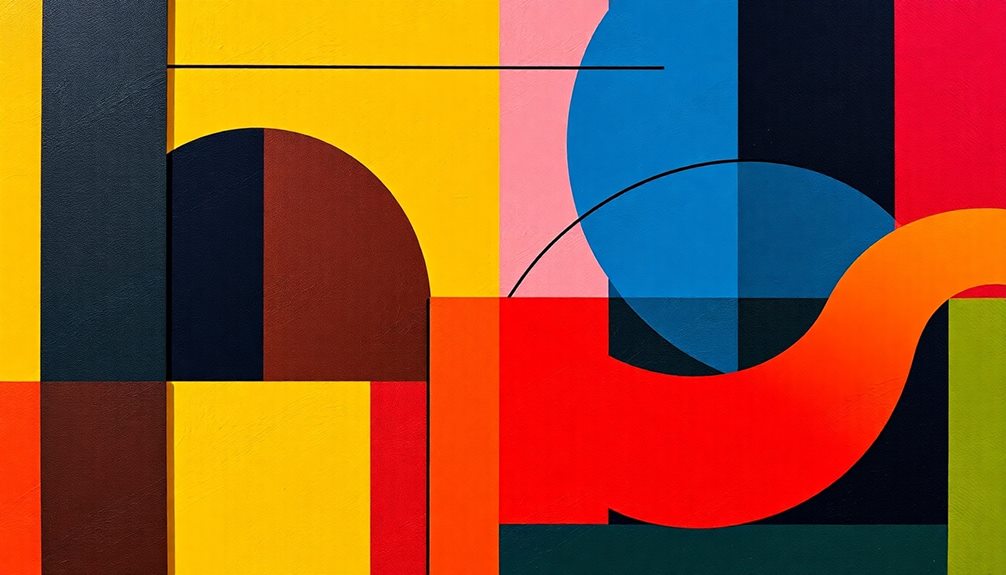Formalism in art focuses on the visual elements like color, line, and texture, prioritizing these over narrative or context. It gained popularity in the late 19th and early 20th centuries, influenced by movements such as Cubism and Abstract Expressionism. Notable figures, like Clement Greenberg, championed the idea of "significant form," which highlights how visual arrangements evoke emotional responses. This approach sparked debates about the role of art in reflecting social issues, making it both praised and critiqued. Exploring Formalism further can deepen your understanding of its core principles and the artworks that embody this distinctive perspective.
Key Takeaways
- Formalism emphasizes intrinsic qualities of art, such as color, line, and texture, prioritizing visual experience over subject matter.
- The concept of "significant form," introduced by Clive Bell, highlights how visual arrangements evoke emotional responses.
- Formalism emerged in the late 19th century and is linked to movements like Cubism and Abstract Expressionism.
- Critics argue that Formalism neglects social and political context, focusing too much on aesthetic value.
- Key figures in Formalism include Clement Greenberg and Clive Bell, whose works explore the significance of formal qualities in art.
Introduction

Formalism in art focuses on the intrinsic qualities of artworks, emphasizing the arrangement of elements like color, line, and texture. You'll find that this critical approach gained momentum in the mid-19th century, particularly alongside movements like Cubism.
While many art theories dive into subject matter or context, Formalism dominated by prioritizing the visual experience instead. This focus on the visual experience can be likened to the importance of keeping memories alive through meaningful tributes in emotional reflections.
Notable figures, including Clement Greenberg and Clive Bell, shaped its framework. Greenberg articulated the importance of these formal elements, while Bell introduced the notion of "significant form" in 1914, highlighting how aesthetic qualities evoke emotional responses.
This perspective allows you to appreciate a work of art for its visual composition rather than its narrative or historical context.
However, the independence from social or political considerations has sparked debates about Formalism's ethical responsibilities. Critics argue that by ignoring context, you risk overlooking important meanings within the artwork.
Still, Formalism remains a significant theory in art criticism, as it fosters an appreciation for the aesthetic that can resonate deeply with viewers. By exploring this approach, you'll gain a clearer understanding of how formal elements contribute to the overall impact of a work of art.
Key Concepts and Definitions

Often, art critics and enthusiasts focus on the visual elements that define a piece, such as color, line, shape, and texture. In the context of Formalism, these elements are paramount, taking precedence over the subject matter or narrative content.
A key concept within this framework is "significant form," introduced by Clive Bell in 1914. He argued that the arrangement of forms in a work of art can evoke emotional responses, allowing viewers to connect with the piece on a deeper level. This approach can be likened to how air purifiers effectively filter pollutants, emphasizing the importance of the elements that contribute to a clearer atmosphere.
Formalism gained traction in the late 19th and early 20th centuries as artists began embracing abstraction and non-representational forms, moving away from realistic depictions. Influential figures like Clement Greenberg championed the importance of medium specificity and the formal qualities that make a work stand out.
Formalism is closely associated with movements like Cubism and Abstract Expressionism, where artists explore the relationships among compositional elements to create meaning.
Fundamental Principles of Formalism

At its core, the principles of Formalism revolve around the intrinsic qualities of art that create visual impact. This approach emphasizes purely visual elements such as color, line, texture, and composition, which can ignite the creative spark in individuals. Instead of focusing on narrative or contextual content, Formalism invites you to analyze how these compositional elements interact to evoke emotional responses.
Clive Bell's concept of "significant form" suggests that the arrangement of these elements is vital in generating feelings within the viewer. Formalism emerged as a reaction against movements like Impressionism, which prioritized atmospheric effects over formal qualities.
Key figures, including Clement Greenberg, championed the idea that the essence of art lies in its form, advocating for a rigorous examination of its compositional elements. This focus on form played a crucial role in shaping modern art movements, particularly Abstract Expressionism.
In this context, artists explore color and structure independently from representation, showcasing the power of visual elements. By embracing these principles, you can deepen your appreciation for how art communicates through its intrinsic qualities, offering a richer understanding of the visual world.
Notable Formalist Artworks

Exploring notable Formalist artworks reveals how artists emphasize visual elements to convey meaning. Paul Cézanne's "The Bathers" showcases compositional structure and color relations, prioritizing these aspects over narrative content.
In modern art, Jackson Pollock's "No. 5, 1948" exemplifies Abstract Expressionism and Formalism by creating an intricate network of lines and colors that focus on the act of painting itself.
Another significant example is Henri Matisse's "The Dance," which embodies Clive Bell's concept of "significant form." Here, the interplay of color and shape evokes emotional resonance without relying on a literal subject.
Piet Mondrian's "Composition with Red, Blue, and Yellow" stands out as a key Formalist piece by reducing form to its essential elements, emphasizing balance and harmony rather than representational accuracy.
Additionally, Barnett Newman's "Vir Heroicus Sublimis" utilizes large fields of color to provoke emotional responses, highlighting the relationship between the viewer and the artwork.
These notable Formalist artworks not only redefine how you perceive modern art but also illustrate the importance of visual elements in conveying deeper meanings.
Tips and Best Practices

To deepen your understanding of Formalism in art, start by familiarizing yourself with its key concepts, particularly "significant form." This principle emphasizes that the aesthetic experience hinges more on visual elements than on the subject matter.
As you dive into the study of art, pay attention to how artists like Paul Cézanne and Jackson Pollock employed formal qualities in their work. Analyze their compositions to see how color, line, and texture create meaning independent of narrative.
Next, attend art critiques or discussions that focus on these visual aspects. By engaging with fellow art enthusiasts, you'll sharpen your ability to observe and articulate your thoughts on form.
Additionally, explore the historical context of Formalism, especially its emergence as a response to Impressionism. Understanding this evolution will enhance your appreciation of its significance in modern art.
Critics' Mixed Reviews

While understanding the principles of Formalism can enhance your appreciation of art, it's important to recognize that not everyone agrees with this perspective. Critics argue that Formalism prioritizes aesthetic qualities over social or political context, leading to a perception of art as disconnected from real-world issues.
Some, particularly those aligned with postmodern views, contend that this emphasis on form neglects the narrative and conceptual elements that provide deeper meaning.
Roger Fry, a prominent figure in the Formalist movement, faced criticism for promoting a conservative stance that many believe stifled progressive artistic expression. Critics claim that this focus on formal qualities can inadvertently support the status quo, ignoring systemic inequalities within the art world.
For them, something went wrong when art became a mere exercise in aesthetics rather than a vehicle for social change.
Despite these critiques, Formalism has undeniably influenced various art movements and remains a significant topic among art historians and critics.
The ongoing debates highlight the complex relationship between art, society, and the interpretations we bring to both. Understanding these mixed reviews can help you navigate the broader conversations surrounding art today.
Critique of Aesthetic Value

A significant aspect of the critique surrounding Formalism is its emphasis on aesthetic value, which prioritizes the visual elements of art—such as form, color, and composition—over narrative or contextual significance. Critics argue that while aesthetic value derived from form can evoke emotional responses, it risks oversimplifying the artwork's meaning.
You might find it compelling that Clive Bell's concept of "significant form" highlights how the arrangement of visual elements is crucial to an artwork's impact, independent of any external references. However, this focus on aesthetic value leads to debates about whether art can be fully appreciated without considering its socio-political context.
Some argue that formalist criticism neglects the complexities of artistic intent and the cultural significance that informs a piece. By concentrating solely on visual qualities, you might overlook how historical events or social issues shape the creation and reception of art.
This critique raises important questions about the role of art in society and whether pure aesthetic value can encompass the full spectrum of human experience. Ultimately, while formalism offers a unique lens through which to view art, its limitations warrant careful consideration.
Additional Resources

Numerous resources are available to deepen your understanding of Formalism in art. Start by exploring key texts, such as Clement Greenberg's essays, which lay the foundation for Formalist theories and highlight the importance of art's visual elements.
For a more comprehensive analysis, check out Stephen E. Melville's book, "Art and Its Significance," where you'll find insights into significant form and its role in art appreciation.
If you're looking for scholarly discussions, visit online platforms like JSTOR, where you can access research papers that explore the evolution and critique of Formalism in art history.
Additionally, engaging with video lectures on platforms like YouTube can be incredibly beneficial. You'll find art historians discussing the principles of Formalism and its influence on modern art movements, providing you with a broader context.
Lastly, consider attending local art exhibitions or lectures that focus on Formalist artists. This firsthand experience will help you understand how form and composition influence viewer perception, enriching your grasp of art beyond its external context.
These resources will significantly enhance your appreciation and understanding of Formalism.
Frequently Asked Questions
What Is Meant by Formalism in Art?
When you think about formalism in art, you're focusing on the visual elements—colors, lines, and shapes—rather than the story. It's all about how these components create emotional responses, independent of any subject matter.
What Is an Example of Formalism?
An example of formalism is Piet Mondrian's work, where you see geometric shapes and primary colors emphasizing form over any real-life subjects. It showcases how structure and composition can evoke emotional responses in viewers.
What Is an Example of a Formalist Approach in Art?
A great example of a formalist approach in art is Piet Mondrian's work. You'll notice his use of geometric shapes and primary colors, focusing on form and structure rather than any specific subject matter.
What Are the Basics of Formalism?
To grasp the basics of formalism, focus on visual elements like color, line, and shape. You'll appreciate how these components evoke emotions, independent of subject matter, making the artwork's form paramount in your analysis.
Conclusion
In conclusion, understanding formalism in art opens up new ways to appreciate and analyze visual works. By focusing on elements like color, shape, and composition, you'll deepen your experience and engagement with art. Remember, while formalism emphasizes aesthetics, it's just one lens through which to view artistic expression. Explore various artworks and apply these principles, but don't forget to consider other perspectives. Dive in, experiment, and let your appreciation for art grow!








